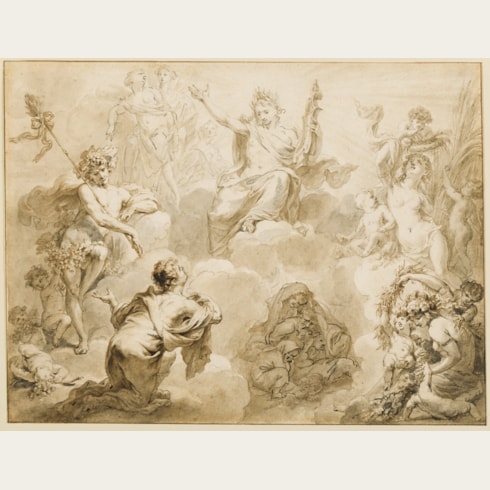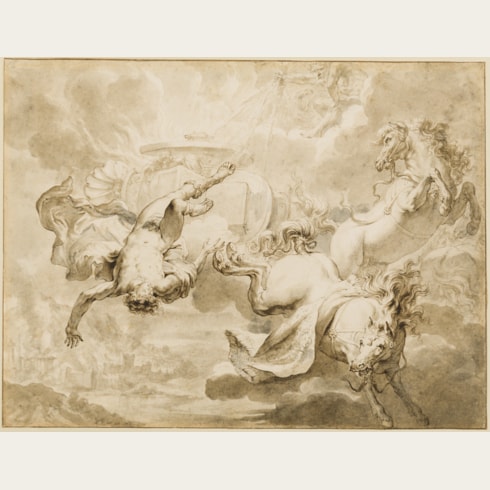Godfried MAES
(Antwerp 1649 - Antwerp 1700)
Phaeton in the Chariot of the Sun God
Sold
Pen and brown ink and brown and gray wash, with framing lines in brown ink.
177 x 232 mm. (7 x 9 1/8 in.)
177 x 232 mm. (7 x 9 1/8 in.)
Godfried Maes produced drawings both as preparatory studies for paintings and as finished, independent works. Arguably the most significant example of the latter are a series of eighty-three elaborate pen and wash drawings illustrating various episodes from Ovid’s Metamorphoses, of which the present sheet is one. Perhaps intended as book illustrations or designs for prints, these highly refined drawings were, however, never reproduced or published in his lifetime. In 1717 the artist’s widow sold all the drawings to the artist Jacob de Wit, who later used some of them as models for his own designs for illustrations, engraved under the supervision of Bernard Picart, for a 1732 translation of The Metamorphoses into Dutch, French and English editions.
This, the second drawing from the series, depicts Phaeton on the chariot of the Sun. The horses, feeling the chariot lighter than usual, go out of control, and the frightened youth drops the reins:
‘the team of four run wild and leave the beaten track, no longer running in their pre-ordained course. He was terrified, unable to handle the reins entrusted to him, not knowing where the track was, nor, if he had known, how to control the team… When the unlucky Phaethon looked down from the heights of the sky at the earth far, far below he grew pale and his knees quaked with sudden fear, and his eyes were robbed of shadow by the excess light. Now he would rather he had never touched his father’s horses, and regrets knowing his true parentage and possessing what he asked for…robbed of his wits by chilling horror, he dropped the reins. When the horses feel the reins lying across their backs, after he has thrown them down, they veer off course and run unchecked through unknown regions of the air. Wherever their momentum takes them there they run, lawlessly, striking against the fixed stars in deep space and hurrying the chariot along remote tracks. Now they climb to the heights of heaven, now rush headlong down its precipitous slope, sweeping a course nearer to the earth.’
This, the second drawing from the series, depicts Phaeton on the chariot of the Sun. The horses, feeling the chariot lighter than usual, go out of control, and the frightened youth drops the reins:
‘the team of four run wild and leave the beaten track, no longer running in their pre-ordained course. He was terrified, unable to handle the reins entrusted to him, not knowing where the track was, nor, if he had known, how to control the team… When the unlucky Phaethon looked down from the heights of the sky at the earth far, far below he grew pale and his knees quaked with sudden fear, and his eyes were robbed of shadow by the excess light. Now he would rather he had never touched his father’s horses, and regrets knowing his true parentage and possessing what he asked for…robbed of his wits by chilling horror, he dropped the reins. When the horses feel the reins lying across their backs, after he has thrown them down, they veer off course and run unchecked through unknown regions of the air. Wherever their momentum takes them there they run, lawlessly, striking against the fixed stars in deep space and hurrying the chariot along remote tracks. Now they climb to the heights of heaven, now rush headlong down its precipitous slope, sweeping a course nearer to the earth.’
The Flemish painter and draughtsman Gotfried Maes studied in his native Antwerp with his father and with the painter Pieter van Lint. He was admitted to the painter’s guild in Antwerp in 1672, becoming dean of the guild ten years later. He spent his entire career in Antwerp, receiving commissions for altarpieces and history paintings from churches and collectors in Antwerp, Brussels and Liège. Much of his work is in a grand scale, such as a large altarpiece of The Martyrdom of Saint George, painted in 1681 for the Antwerp church of St. Joris and today in the Koninklijk Museum voor Schone Kunsten in Antwerp, and Maes may be regarded as among the last of the Flemish Baroque artists. Among his important patrons was Eugen Alexander Franz, Prince of Thurn and Taxis, for whose palace in Brussels he painted an allegorical ceiling painting glorifying the Thurn and Taxis family. Maes worked as a designer of tapestry cartoons, often in collaboration with the tapestry workshop of Urbanus Leyniers in Brussels, and also produced book illustrations and a number of etchings. One of his last major decorative projects was the ceiling decoration of the Palace of Coudenberg in Brussels for the governor of the Spanish Netherlands, Maximilian II Emanuel, Elector of Bavaria; on which he worked between 1697 and 1700.
A gifted draughtsman, Maes produced numerous drawings, both as preparatory studies for paintings and as finished, independent works. Arguably the most significant example of the latter group are a series of 83 elaborate pen and wash drawings illustrating various episodes from Ovid’s Metamorphoses. Perhaps intended as book illustrations or designs for prints, these refined drawings were, however, never reproduced or published in his lifetime. In 1717 the artist’s widow sold all the drawings to the art dealer Jacob de Wit, and they were eventually used as illustrations for a 1732 translation of the Metamorphoses into French. The original drawings by Maes remained together until 1762, when they were dispersed at auction in Amsterdam.
Drawings by Maes are today in the collections of the Rijksmuseum in Amsterdam, the Musea Brugge in Bruges, the Wallraf-Richartz-Museum in Cologne, the Hessisches Landesmuseum in Darmstadt, the Hamburger Kunsthalle in Hamburg, the British Museum in London, the Yale University Art Gallery in New Haven, the University Library in Leiden, the Metropolitan Museum of Art in New York, the Louvre and the Fondation Custodia in Paris, the Museum Boijmans-van Beuningen in Rotterdam, the Eesti Kunstimuuseum in Tallinn, the Biblioteca Reale in Turin, the Albertina in Vienna, and elsewhere.
Provenance
Part of a series of eighty-three drawings of scenes from Ovid’s Metamorphoses with provenance as follows:
The artist’s widow, Josina Baeckelandt, Antwerp
Sold by her, sometime before 1717, for 800 florins to Jacob de Wit, Amsterdam
His posthumous sale, Amsterdam, de Leth, 10 March 1755 onwards, in Kunstboek U (‘Waarïn de Herscheppingen van Ovidius, in Drieëntagtig uitvoerige Teekeningen, door G. Maas. Welke in één koop verkocht zullen worden.’, bt. Cronenburgh)
B. Cronenburgh, Amsterdam
His posthumous sale, Amsterdam, de Leth, 22-25 March 1762, portfolio A, no.1 (‘Drie-en-tachentig Teekeningen uit de Ovidius, alle zeer uitvoerig met Oost-Indische Inkt geteekend door G. Maas, en een weinigje geretoucheerd door J. de Wit.’)
The drawings thereafter divided
Possibly Graaf van Neale, Amsterdam(?)
Possibly his posthumous sale, Amsterdam, de Winter Zweertz, 28 March 1774 onwards, Portfolio 1, lot 542
Anonymous sale, Amsterdam, Mak van Waay, 15 January 1974, part of lot 1273 (‘Dertig tekeningen met voorstellingen van mythologische scenes o.a. betrekking hebbend op Ovidius’ Metamorfosen’, bt. Dreesmann)
Anton C.R. Dreesmann, Amsterdam
His posthumous sale, London, Christie’s, 11 April 2002, part of lot 666
Thomas Williams Fine Art Ltd., London, in 2003
Private collection.
The artist’s widow, Josina Baeckelandt, Antwerp
Sold by her, sometime before 1717, for 800 florins to Jacob de Wit, Amsterdam
His posthumous sale, Amsterdam, de Leth, 10 March 1755 onwards, in Kunstboek U (‘Waarïn de Herscheppingen van Ovidius, in Drieëntagtig uitvoerige Teekeningen, door G. Maas. Welke in één koop verkocht zullen worden.’, bt. Cronenburgh)
B. Cronenburgh, Amsterdam
His posthumous sale, Amsterdam, de Leth, 22-25 March 1762, portfolio A, no.1 (‘Drie-en-tachentig Teekeningen uit de Ovidius, alle zeer uitvoerig met Oost-Indische Inkt geteekend door G. Maas, en een weinigje geretoucheerd door J. de Wit.’)
The drawings thereafter divided
Possibly Graaf van Neale, Amsterdam(?)
Possibly his posthumous sale, Amsterdam, de Winter Zweertz, 28 March 1774 onwards, Portfolio 1, lot 542
Anonymous sale, Amsterdam, Mak van Waay, 15 January 1974, part of lot 1273 (‘Dertig tekeningen met voorstellingen van mythologische scenes o.a. betrekking hebbend op Ovidius’ Metamorfosen’, bt. Dreesmann)
Anton C.R. Dreesmann, Amsterdam
His posthumous sale, London, Christie’s, 11 April 2002, part of lot 666
Thomas Williams Fine Art Ltd., London, in 2003
Private collection.
Literature
J. van Tatenhove, ‘Tekeningen door Jacob de Wit voor de Ovidius van Picart’, Leids Kunsthistorisch Jaarboek 1985: Achttiende-Eeuwse Kunst in de Nederlanden, 1987, p.233, note 40; ‘Drawings in London, 5-11th July 2003’, The Burlington Magazine, June 2003, unpaginated, illustrated; Clifford S. Ackley, ‘The Intuitive Eye: Drawings and Paintings from the Collection of Horace Wood Brock’, in Horace Wood Brock, Martin P. Levy and Clifford S. Ackley, Splendor and Elegance: European Decorative Arts and Drawings from the Horace Wood Brock Collection, exhibition catalogue, Boston, 2009, p.97 and p.158, no.134, illustrated p.132.
Exhibition
Boston, Museum of Fine Arts, Splendor and Elegance: European Decorative Arts and Drawings from the Horace Wood Brock Collection, 2009, no.134.








